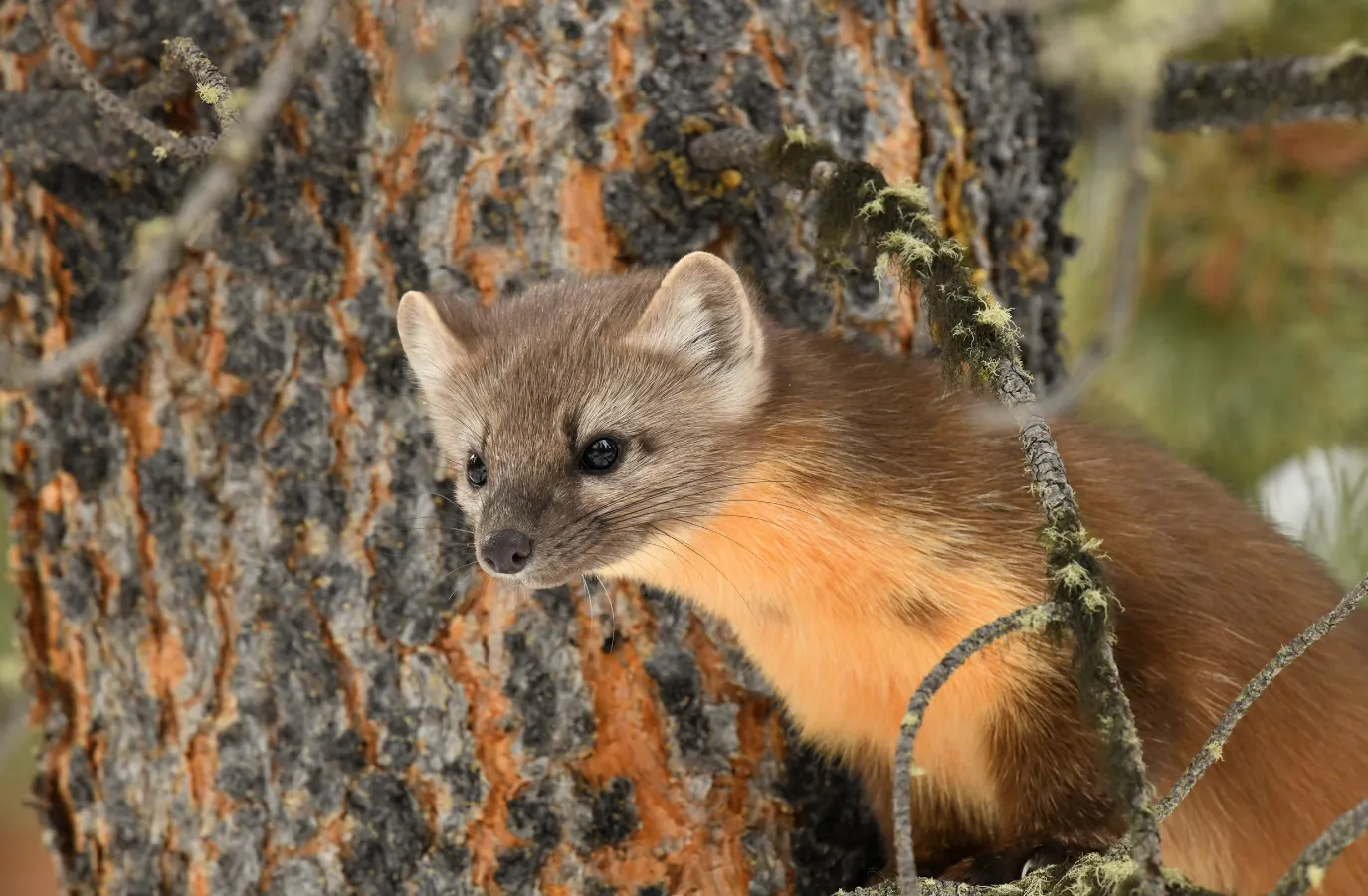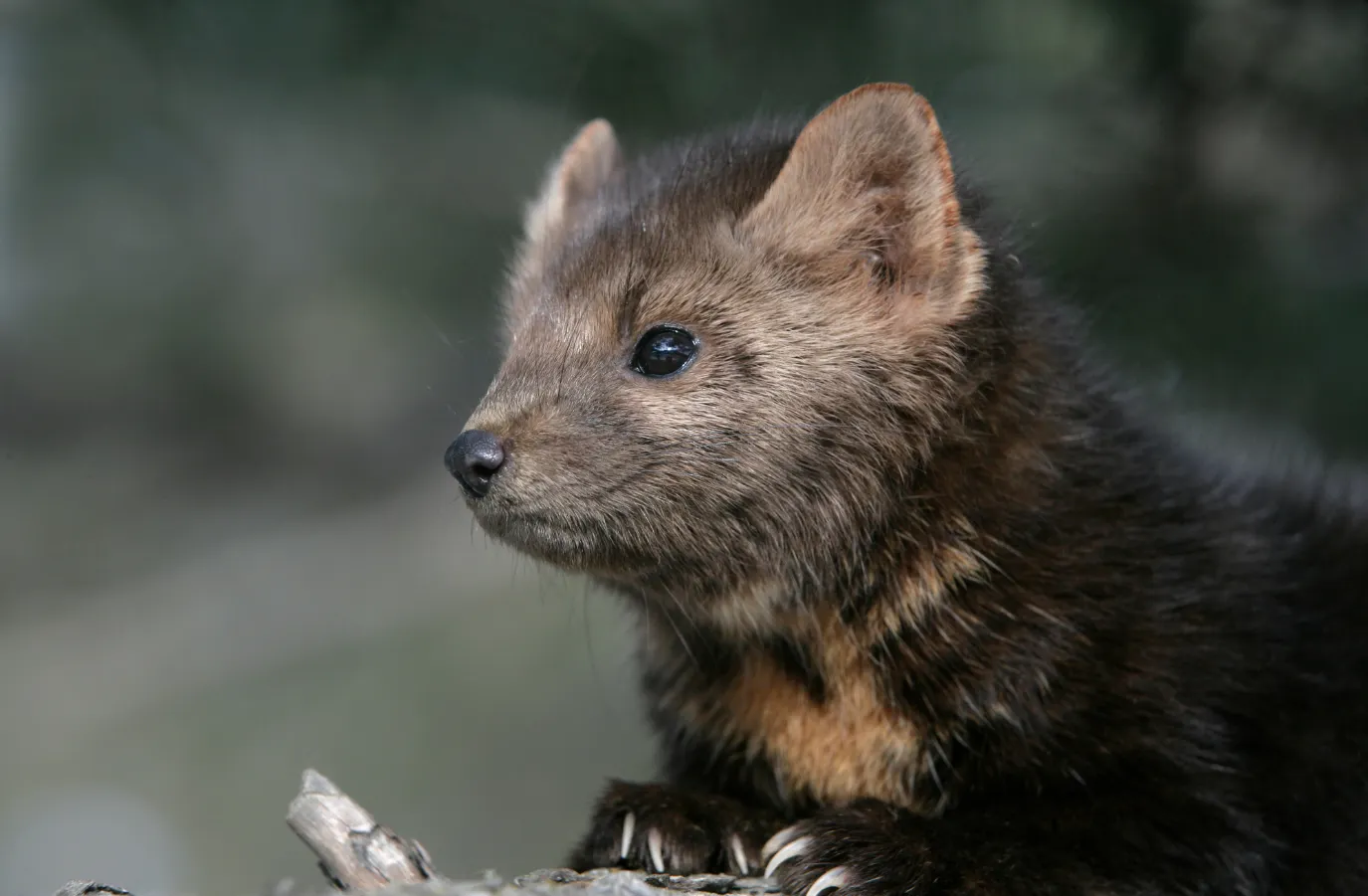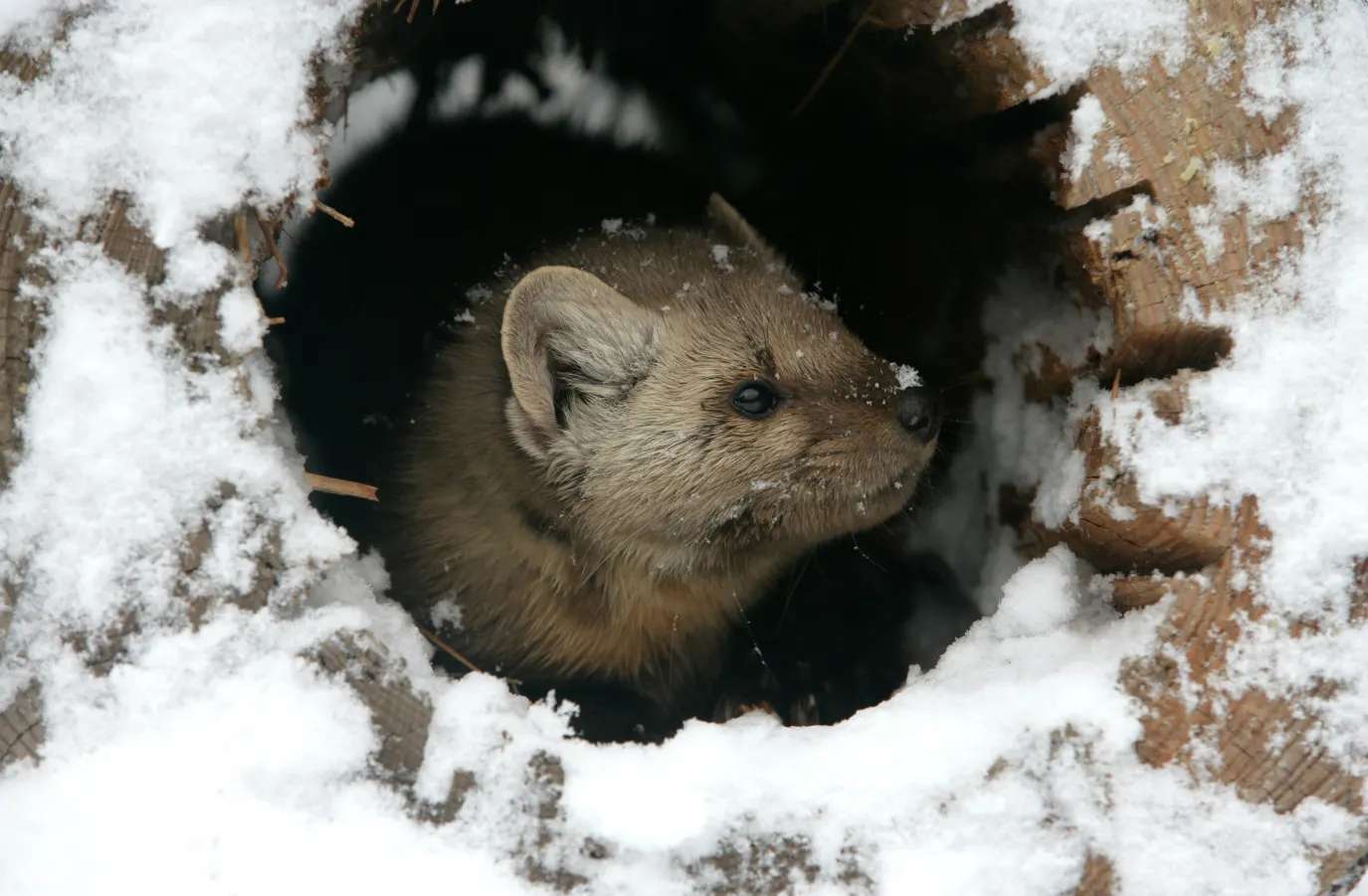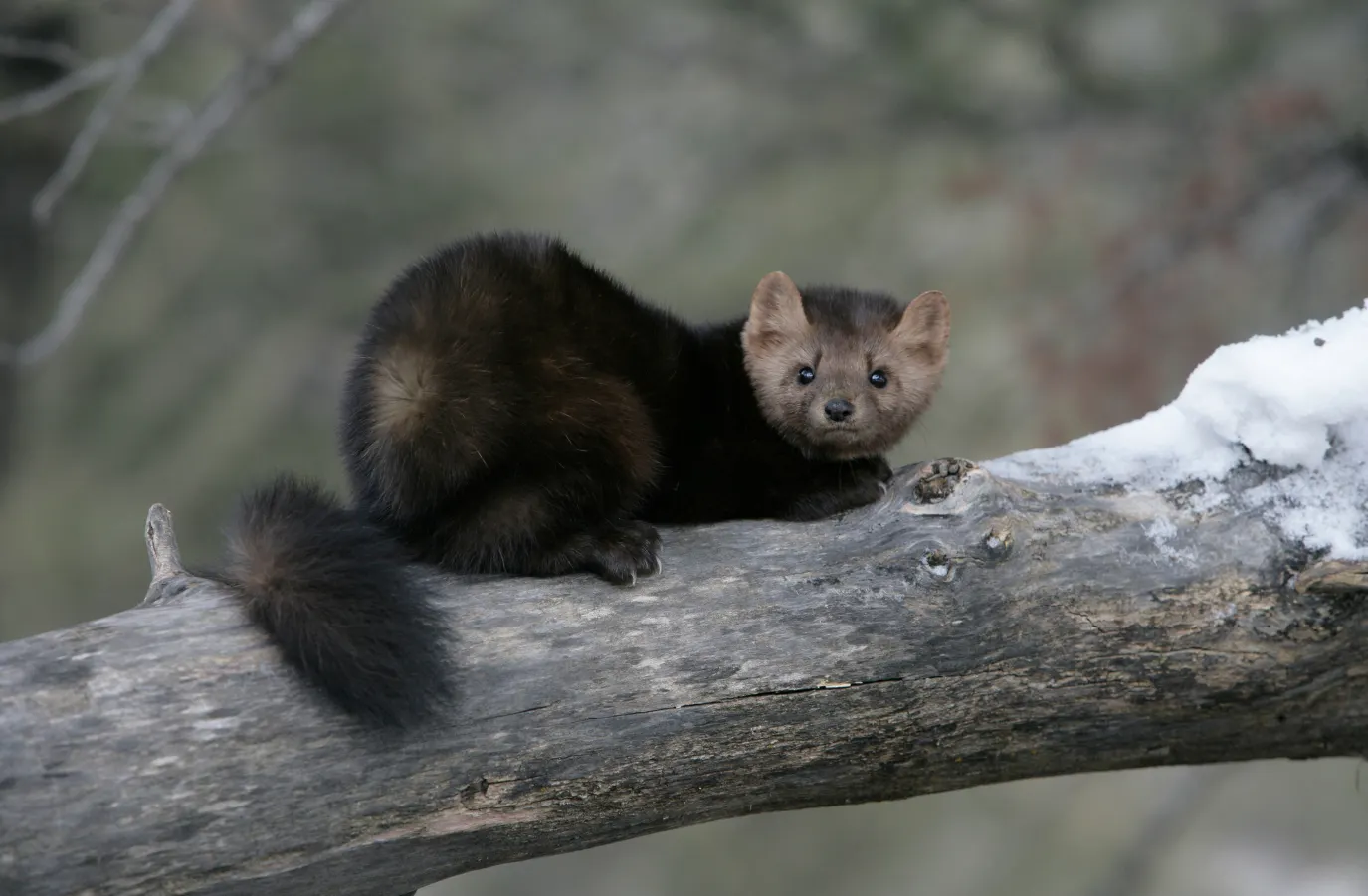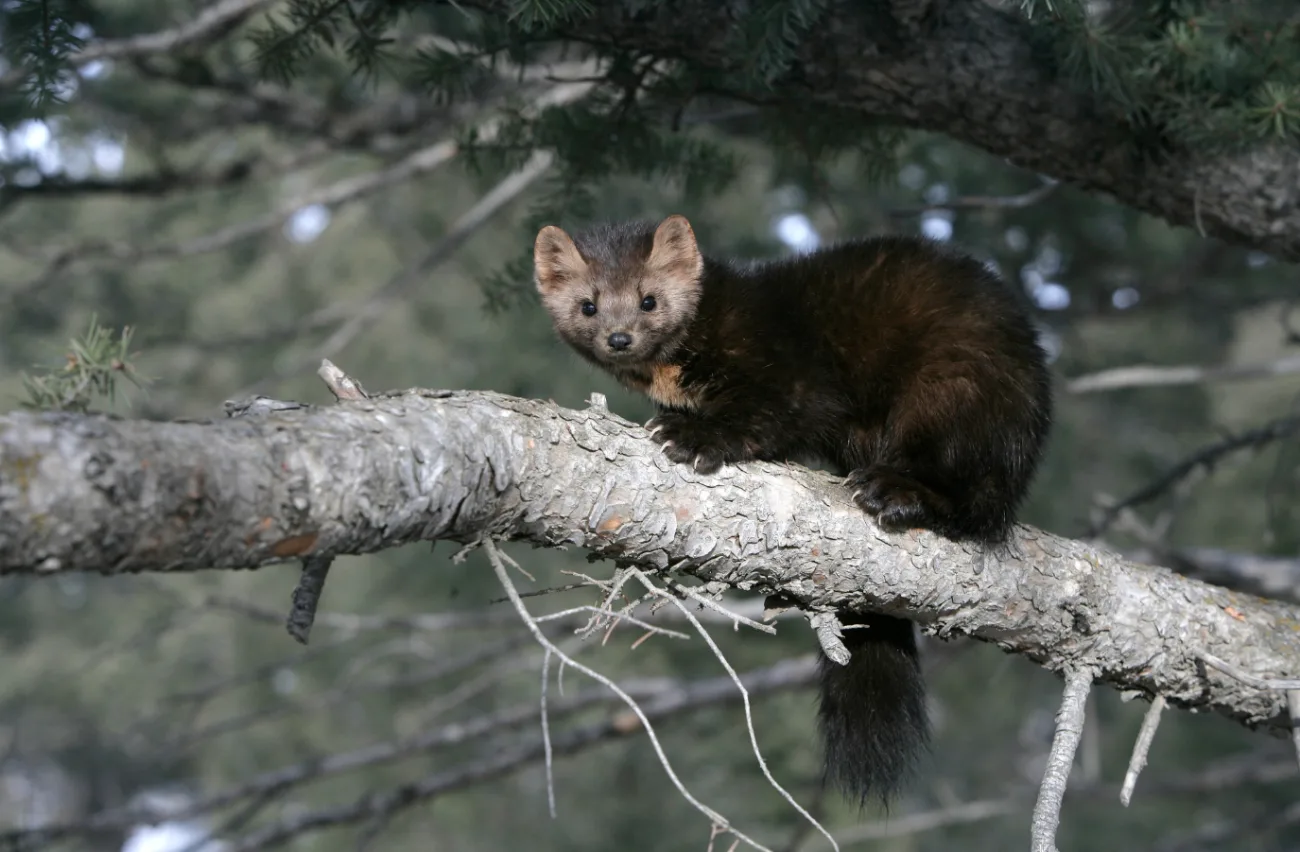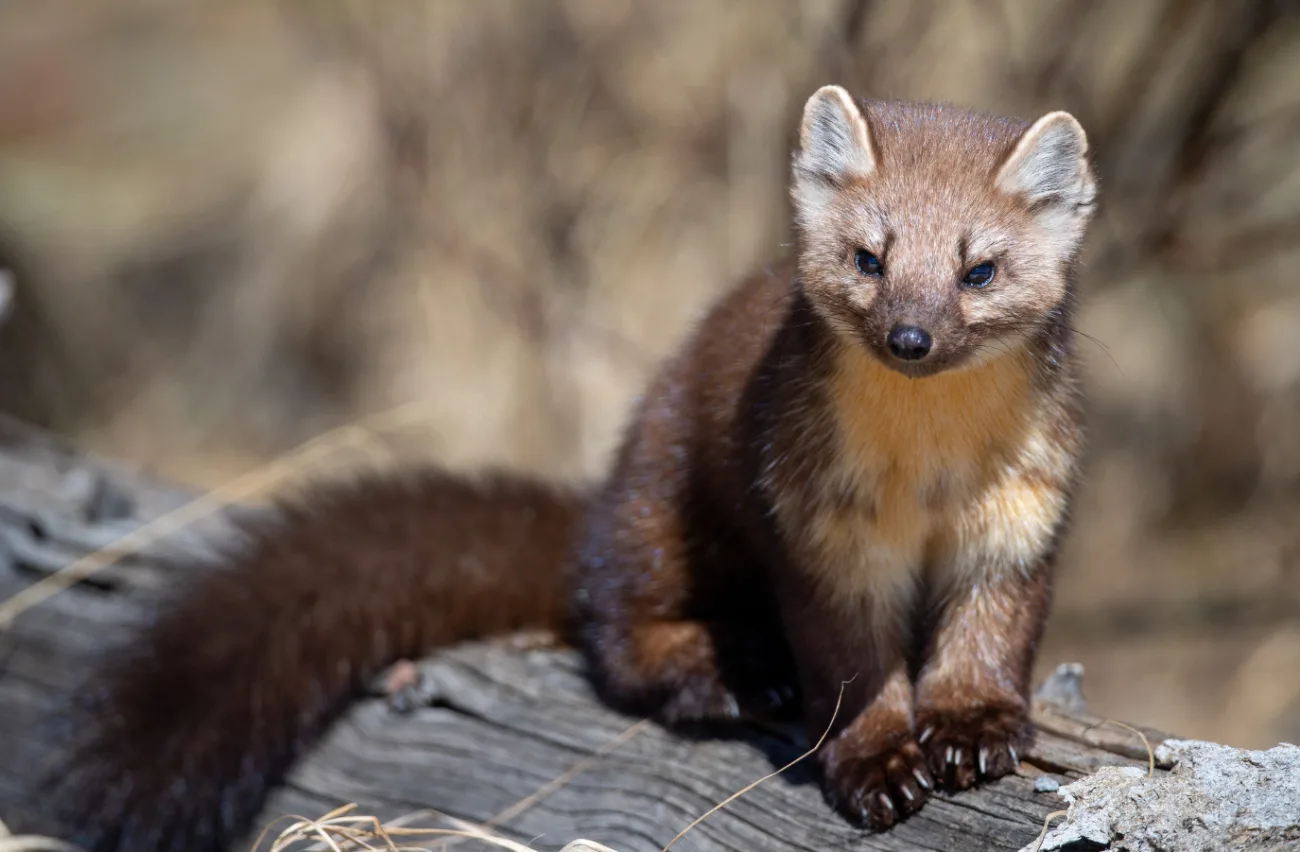The American marten, scientifically known as Martes americana, is a captivating North American mammal renowned for its unique characteristics.
Often called the American pine marten, this species has a rich history and holds a special place in the diverse ecosystems it inhabits throughout the continent. With its sleek, slender body and fur ranging from yellowish to brown, it stands out in the wilderness.
Unlike its larger cousin, the fisher, the marten is lighter in color and has a distinct bib of a different hue. These solitary creatures have an omnivorous diet that changes with the seasons, favoring small mammals like voles.
Scientific Classification
| Kingdom | Animalia |
|---|---|
| Phylum | Chordata |
| Class | Mammalia |
| Order | Carnivora |
| Family | Mustelidae |
| Genus | Martes |
| Species | Martes americana |
Appearance and Adaptations of the American Marten

The American marten is a visually striking mammal with unique adaptations that enable it to thrive in its forest habitat. Let’s delve deeper into the appearance and adaptations of this fascinating creature.
Size and Body Structure
The American marten is a slender-bodied mammal, measuring approximately 18 to 26 inches (45 to 66 cm) in total length, including its long, bushy tail. Their body structure is elongated, resembling that of a weasel or mink.
They have relatively large, rounded ears and short limbs. One notable feature is their triangular-shaped head and sharp nose, which aids in their hunting abilities.
Fur Color and Texture

The marten’s dense fur coat is truly remarkable, standing out as one of its most striking features. It showcases a captivating array of colors, ranging from delicate shades of pale yellowish-brown to rich, deep browns. The fur’s texture is incredibly soft and silky, offering the marten optimal insulation and protection against the biting cold of winter.
What adds to the fur’s allure is the intriguing contrast in coloration across different parts of the marten’s body. Typically, the head exhibits a lighter hue compared to the rest of its body, creating an alluring juxtaposition.
As we move towards the tail and legs, the fur tends to deepen in color, often displaying darker tones. This variation in coloration adds a touch of elegance to the marten’s appearance.
Moreover, it’s not just the overall fur coat that captivates observers. Many American martens possess a distinct throat and chest bib, which serves as an additional feature of fascination. The color of this bib can vary from gentle, pale straw hues to vibrant and eye-catching shades of orange, further enhancing the marten’s unique charm.
Climbing Abilities

The remarkable climbing abilities of martens are a testament to their exceptional adaptations in the wild. Equipped with sharp, curved claws, these agile creatures possess an innate ability to navigate vertical surfaces with remarkable ease.
Their claws provide them with a secure grip on tree trunks, branches, and other elevated structures, enabling them to ascend trees effortlessly and traverse the intricate network of branches within the forest canopy.
The marten’s climbing prowess serves multiple purposes in its daily life. When it comes to hunting, their climbing abilities grant them access to prey that may seek refuge in the treetops, such as squirrels and birds.
By swiftly scaling trees, they can surprise their quarry and launch successful hunting strategies from above, displaying their agility and stealth in the process.

Additionally, climbing plays a vital role in the marten’s survival strategy. When faced with potential threats or predators on the forest floor, they can rapidly seek refuge in the safety of the trees. Their nimble climbing skills allow them to swiftly escape danger and find sanctuary in the elevated reaches of the forest.
Martens utilize their climbing prowess for shelter and nesting purposes. They often seek out tree cavities or hollows to establish their dens, utilizing the safety and seclusion provided by these elevated spaces. By effortlessly scaling trees, they can access suitable nesting sites, ensuring the protection and comfort of their young.
Heat Conservation
The American marten has certain adaptations that help it conserve heat during cold winters. Despite its relatively small size, it has limited body-fat reserves and experiences high mass-specific heat loss.
To combat this, martens may enter shallow torpor on a daily basis, reducing their metabolic rate and conserving energy.
This torpor helps minimize heat loss during periods of inactivity, enabling them to endure the cold temperatures more effectively.
Sexual Dimorphism

Sexual dimorphism, the distinct physical differences between males and females of a species, is highly pronounced in American martens. Males typically exhibit larger body size compared to females, showcasing a significant disparity in both length and weight.
On average, male martens are approximately 15% longer than their female counterparts. This disparity in length is a notable characteristic of sexual dimorphism in the species. Additionally, male martens can weigh up to 65% more than females, further emphasizing the significant size difference between the sexes.
There are several factors that contribute to this sexual dimorphism in martens. One primary factor is the competition for mates. Larger males often have an advantage in securing mating opportunities and defending territories against rival males.
The increased size and strength of male martens may serve as an advantage during aggressive encounters with competitors, ensuring their dominance and reproductive success.
Differences in reproductive strategies between males and females may also contribute to sexual dimorphism. Female martens invest significant energy and resources in raising their offspring. As a result, they may prioritize energy allocation towards reproduction rather than physical size.
In contrast, male martens may focus more on competing for mates and defending territories, leading to a larger body size as a means of increasing their reproductive success.
Habitat and Distribution

The American marten is primarily found in the boreal forests of North America, including parts of Canada, Alaska, and the northern regions of the United States. They prefer habitats with a combination of coniferous trees, such as spruce, pine, and fir, which provide suitable cover and abundant prey.
What type of habitats do American martens prefer?
American martens prefer a diverse range of habitats that encompass the enchanting realms of North America’s forests and woodlands. These agile and elusive mammals are particularly fond of mature coniferous forests, where they can find an abundance of resources and suitable dens for shelter. Dense forests with a mixture of conifers and hardwoods provide an ideal combination of cover, foraging opportunities, and suitable prey for the martens.
Within these forested landscapes, American martens exhibit a preference for areas with dense vegetation, including dense understory and shrub layers, which offer them ample hiding places and protection from predators. They are also known to inhabit areas near water sources, such as streams, rivers, or wetlands, as these provide additional resources and contribute to the overall ecological richness of their habitat.
In their quest for a suitable home, American martens show adaptability and can occupy a variety of forest types, including montane forests, mixed deciduous forests, and even boreal forests. The availability of old-growth trees, fallen logs, and snags is highly beneficial, as they provide denning sites and opportunities for foraging.
Photos of american martens
Distribution of the American Marten

The American marten (Martes americana) is primarily found in the northern regions of North America, encompassing parts of Canada, Alaska, and the northern United States.
Its distribution extends from the Pacific coast to the Atlantic coast, covering a wide expanse of boreal and temperate forests.
In Canada, the American marten can be found throughout most provinces and territories, including British Columbia, Alberta, Saskatchewan, Manitoba, Ontario, Quebec, Newfoundland and Labrador, Yukon, Northwest Territories, and Nunavut. It is especially abundant in the boreal forests of Canada, where it thrives in the diverse array of habitats available.
In the United States, the American marten’s range extends across several northern states, particularly those with substantial forested areas.
These states include Alaska, Washington, Oregon, Idaho, Montana, Wyoming, Minnesota, Wisconsin, Michigan, New York, Vermont, New Hampshire, and Maine. The specific distribution within these states can vary, with some populations being more concentrated in certain regions.
The American marten’s distribution is influenced by factors such as habitat suitability, prey availability, and historical population dynamics. While primarily associated with northern latitudes, there are some isolated populations that occur at lower elevations and more southerly locations within its overall range.
Has the distribution of American martens changed over time?
Yes, the distribution of American martens has experienced regional contraction and expansion. Local extirpations (local population extinctions) have occurred in some areas, followed by successful recolonizations in other parts of the Great Lakes region and the Northeast.
Reintroduction efforts have also been made in areas where extinction occurred. However, the species is considered extirpated from several states, including Pennsylvania, Maryland, Massachusetts, West Virginia, Ohio, New Jersey, and Illinois.
Types of forests that American Martens inhabit

The habitats favored by American martens encompass a diverse array of forest types, expanding beyond the initial perception of exclusive residence in old conifer forests. Recent research has revealed their adaptability to various ecosystems, including mature and young deciduous forests and coniferous and mixed forests.
Their expansive range extends to regions such as Alaska, Canada, northern New England, and the picturesque Adirondacks in New York. Furthermore, in the heartland of the United States, American martens have established their presence in the forested realms of Wisconsin and vast portions of Minnesota.
Here are some of the forest types that American martens commonly inhabit:
Boreal Forests
American martens are well-adapted to the vast expanse of boreal forests that span across northern regions of North America. These forests consist predominantly of coniferous trees, such as spruce, pine, and fir. The martens find suitable dens and ample foraging opportunities within the dense cover of these boreal forests.
Mixed Deciduous Forests
American martens also inhabit mixed deciduous forests, which are characterized by a combination of broadleaf trees (deciduous) and coniferous trees. These forests provide a diverse habitat with a variety of tree species, such as oak, maple, birch, and hemlock. The presence of both tree types offers the martens a range of resources and potential prey.
Montane Forests
In mountainous regions, American martens can be found in montane forests. These forests occur at higher elevations and are characterized by a mix of coniferous and broadleaf trees. They provide the martens with rugged terrain, diverse vegetation, and a rich array of prey species.
Coniferous Forests
American martens exhibit a particular affinity for coniferous forests, where they can often be found. These forests consist mainly of cone-bearing trees, such as spruce, pine, cedar, and fir. The dense cover, abundance of fallen logs, and suitable denning sites make coniferous forests an ideal habitat for these agile mammals.
Mature Forests
American martens show a preference for mature forests, characterized by older, established trees. These forests provide a more complex structure with a well-developed canopy, understory vegetation, and fallen debris, which create a diverse range of microhabitats that suit the martens’ needs.
Primary threats to the American marten population
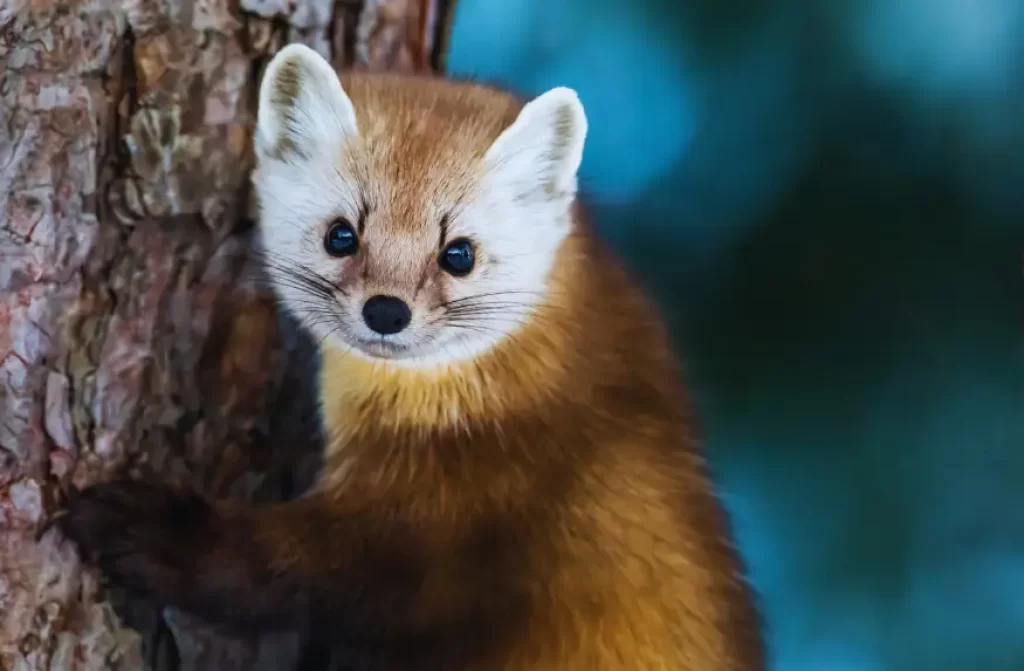
The American marten population has encountered significant threats, particularly arising from trapping practices and habitat destruction. These factors have posed challenges to their overall well-being.
However, when compared to the fisher, another carnivorous mammal of similar ecological niche, the American marten has managed to maintain a relatively more abundant population.
It is important to note that the Newfoundland subspecies of the American marten, known as M. a. atrata, faces a more precarious situation and is considered to be under the threat category. Conservation efforts are crucial to safeguard the future of this subspecies and ensure its continued survival.
Interactions and Hybridization among Marten Species
In specific regions, intriguing interactions and hybridization occur between the Pacific and American martens, resulting in a fascinating natural hybrid zone.
This zone has been identified in the breathtaking Columbia Mountains, as well as on the picturesque islands of Kupreanof and Kuiu in Alaska. However, it is essential to recognize that translocations of American martens without due consideration for the Pacific martens have introduced a potential threat to the latter species.
In certain areas, such as the captivating Dall Island, the introduction of American martens has led to hybridization with the native Pacific marten population. This hybridization, while captivating from an evolutionary perspective, raises concerns for the conservation of Pacific martens.
Genetic evidence indicates the presence of introgression, where genetic material from American martens has infiltrated other parts of the Pacific marten’s range.
These introductions of American martens are likely responsible for such genetic intermingling.
Diet of American Martens
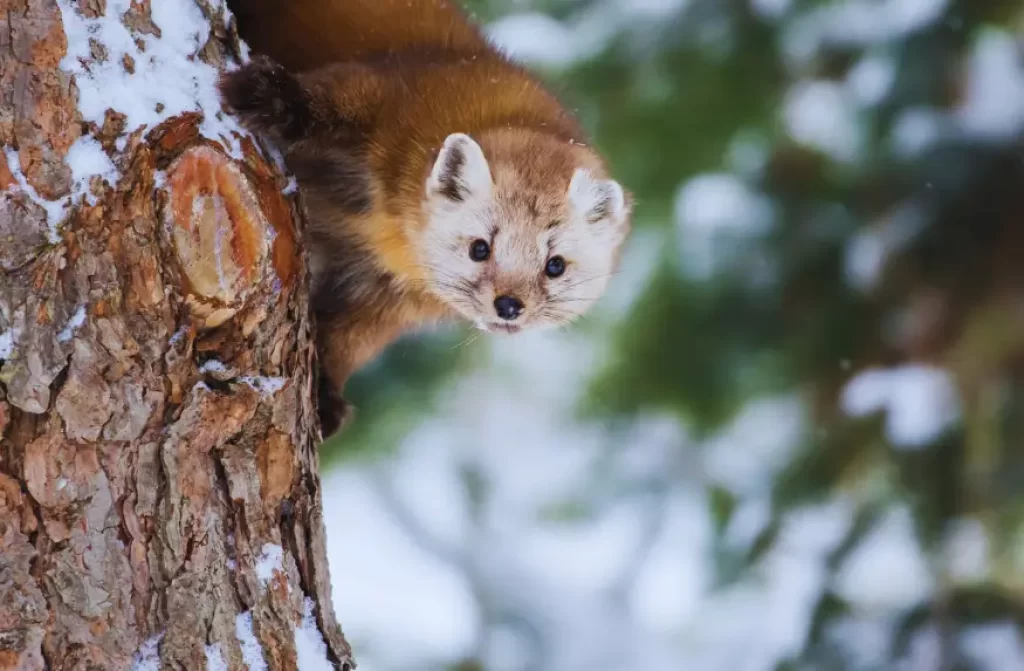
Martens exhibit a remarkable adaptability as opportunistic hunters, showcasing a diverse palate. Their diet predominantly consists of small mammals, such as squirrels, voles, rabbits, and birds. Equipped with exceptional agility and climbing skills, martens adeptly pursue and capture their prey in the lofty realms of treetops.
Beyond their mammalian prey, martens also incorporate insects, fruits, nuts, and even carrion into their diet when circumstances demand.
This flexibility allows them to exploit a wide range of available food sources, adjusting their preferences based on the specific resources found within their habitat.
Martens’ dietary choices are influenced by the ever-changing availability of food in their environment.
They are adept at adapting their foraging strategies to match the prevailing conditions, ensuring their sustenance even during times of scarcity. This flexibility in diet contributes to their survival and ecological success in diverse habitats.
Behavior of American Martins
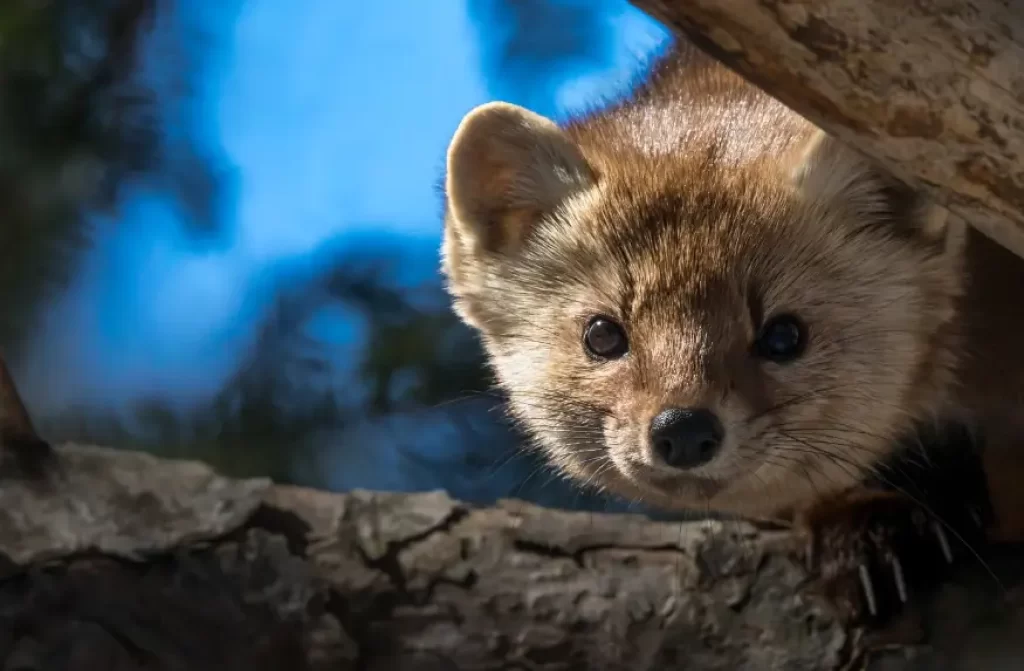
Martens, fascinating creatures of the wilderness, exhibit a range of behaviors that contribute to their survival and success in their respective habitats. Solitary by nature, they typically lead a solitary lifestyle, preferring to navigate their surroundings independently and avoiding extensive social interactions.
This solitary behavior grants them the freedom to roam, forage, and secure resources without the constraints of group coordination.
Nocturnal in their habits, martens are primarily active during the cover of night. Under the moonlit sky, they engage in their pursuits with heightened senses, taking advantage of the darkness to navigate their environment stealthily. Their nocturnal behavior allows them to exploit prey that are more active during nighttime and minimize encounters with potential predators.
Scent Marking and Territorial Behavior
An intriguing aspect of marten behavior lies in their utilization of scent marking as a means of communication and territorial assertion.
Through specialized scent glands, martens engage in scent marking to leave their olfactory imprint on trees, rocks, and other surfaces within their territory. This act serves as a powerful message to their fellow martens, signaling their presence and demarcating the boundaries of their domain.
Scent marking is an essential behavior that helps prevent conflicts and establish dominance among individuals. By conveying their territorial ownership through scent, martens reduce the likelihood of physical confrontations, allowing for a more harmonious coexistence within their communities.
Breeding and Reproduction of American martens
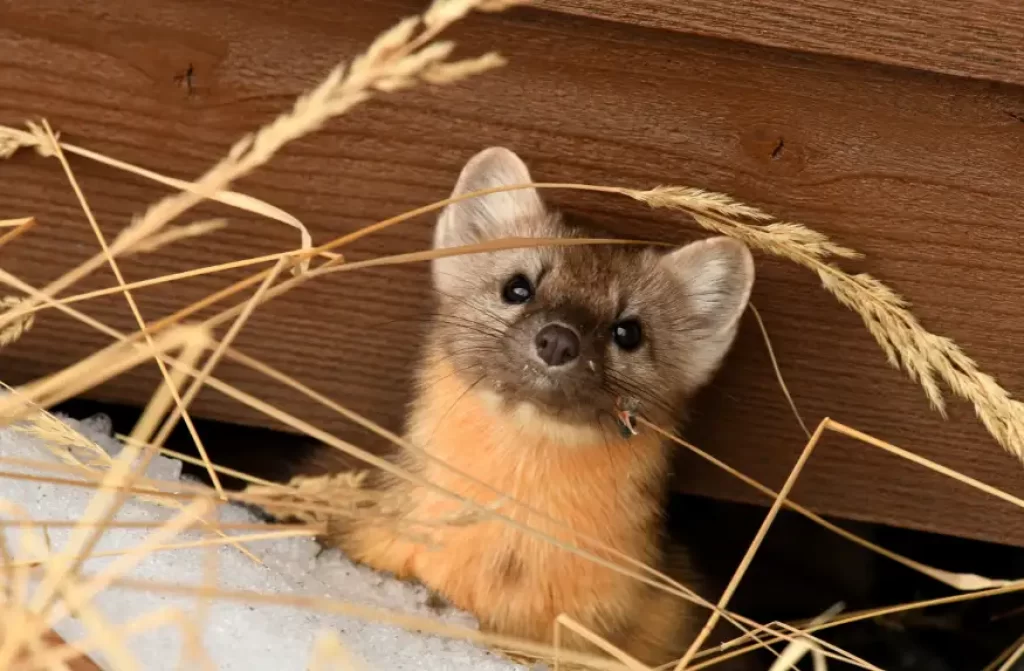
Breeding among American martens typically occurs during the summer months. Females experience delayed implantation of fertilized eggs, ensuring that gestation aligns with the availability of food resources. After a gestation period of approximately 9 months, females give birth to a litter of 2 to 5 kits.
Denning Behavior
Martens utilize various types of dens, each serving a specific purpose in their reproductive and nurturing processes. These dens can be categorized into two primary types: natal dens and maternal dens.
Natal dens hold a special significance as they serve as the birthplace for martens. These dens provide a safe and secluded environment for females during the critical time of parturition.
Within the comfort and security of a natal den, female martens bring new life into the world, ensuring the survival of their offspring. These dens are carefully chosen by the females to offer optimal protection and privacy during the vulnerable stages of birth.
Once the kits are born, the females subsequently relocate them to maternal dens. These dens serve as nurturing hubs where the mothers provide care and protection for their growing kits.
Maternal dens offer a secure refuge, shielding the young martens from potential threats while fostering their growth and development. Within the confines of a maternal den, the kits receive nourishment, learn essential survival skills, and bond with their mother.
Development of Young
The kits are born blind and entirely dependent on their mother for nourishment and protection. Weaning typically occurs at around 42 days, and the young emerge from the dens at approximately 50 days, although the mother may move them before this.
At 7 to 8 weeks, the kits in northwestern Maine are active but may lack coordination. However, by 12 to 15 weeks, they gain coordination and reach adult body weight around 3 months.
Dispersal and Independence
The journey towards independence marks a significant milestone in the lives of young martens, known as kits. Initially, kits spend their first summer in the close company of their mother, benefiting from her guidance and care.
However, as the fall season approaches, a transformative process unfolds as the kits disperse, venturing beyond their mother’s territory to establish their own domain.
The timing of juvenile dispersal exhibits some variation across the distribution range of the American marten.
It encompasses a period spanning from early August to October, representing a critical phase in their transition to independence. In the south-central Yukon region, specifically, juveniles embark on their dispersal journey from mid-July to mid-September, aligning with the onset of female estrus.
This timing ensures that the young martens have an opportunity to explore and establish their own territories before the mating season.
Interestingly, there have been intriguing observations indicating that in certain regions, juvenile dispersal may also occur during early spring.
This alternative dispersal period allows for a unique dynamic, potentially influenced by local environmental conditions and resource availability. Such observations emphasize the adaptability and flexibility of martens in responding to the specific demands of their habitat.
Overall, the reproductive cycle and development of young in American martens are intricately tied to the availability of resources and the need to establish independent territories. These adaptive behaviors ensure the survival and continuity of the species in their habitat.
Conservation Status and Threats
The American marten is considered a species of least concern according to the International Union for Conservation of Nature (IUCN). However, localized populations may face threats due to habitat loss, fragmentation, and climate change.
Logging and the conversion of forests for human development can disrupt their habitat and limit their access to prey. Conservation efforts focus on preserving intact forest ecosystems, implementing sustainable logging practices, and protecting critical marten habitats.
Frequently asked questions
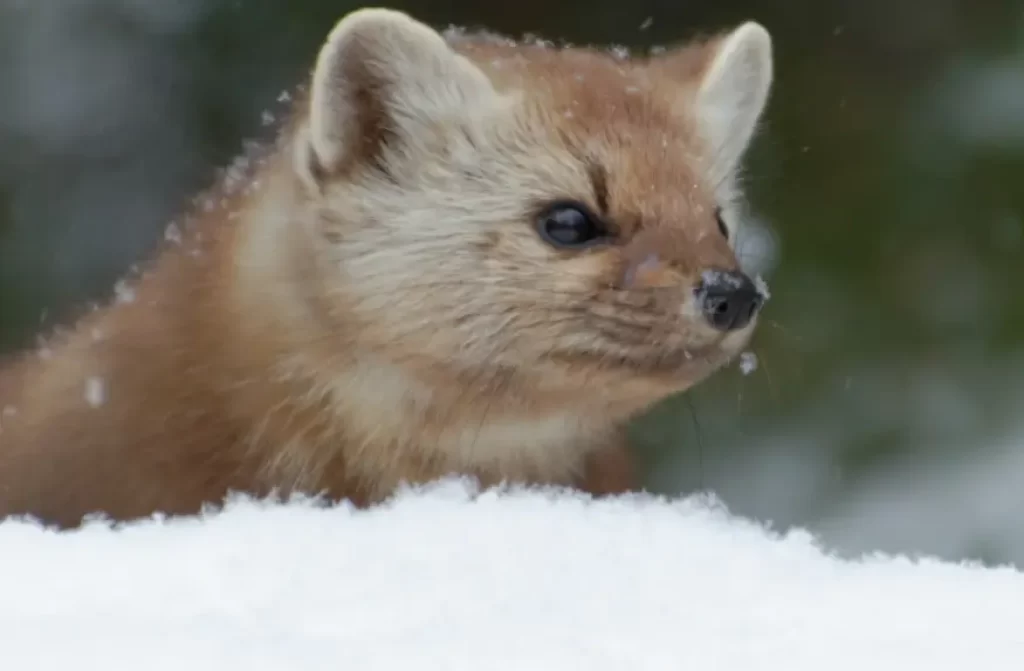
Do martens ever engage in social interactions with other martens?
While martens typically prefer a solitary lifestyle, there are instances where they may interact with other martens, particularly during mating season or encounters at territorial boundaries.
What do American martens eat?
American martens are opportunistic hunters with a diverse diet. They primarily prey on small mammals such as squirrels, voles, rabbits, and birds. Additionally, they consume insects, fruits, nuts, and even carrion when necessary. Their diet varies depending on the availability of food sources in their habitat.
How do martens benefit from their solitary behavior?
Martens’ solitary nature allows them the freedom to roam and forage without the need for group coordination. It also reduces competition for resources within their habitat.
Are martens active during the day or night?
Martens are primarily active during the night, exhibiting nocturnal behavior. This behavior helps them avoid potential predators and take advantage of prey that are more active during nighttime.
Why do martens prefer a solitary lifestyle?
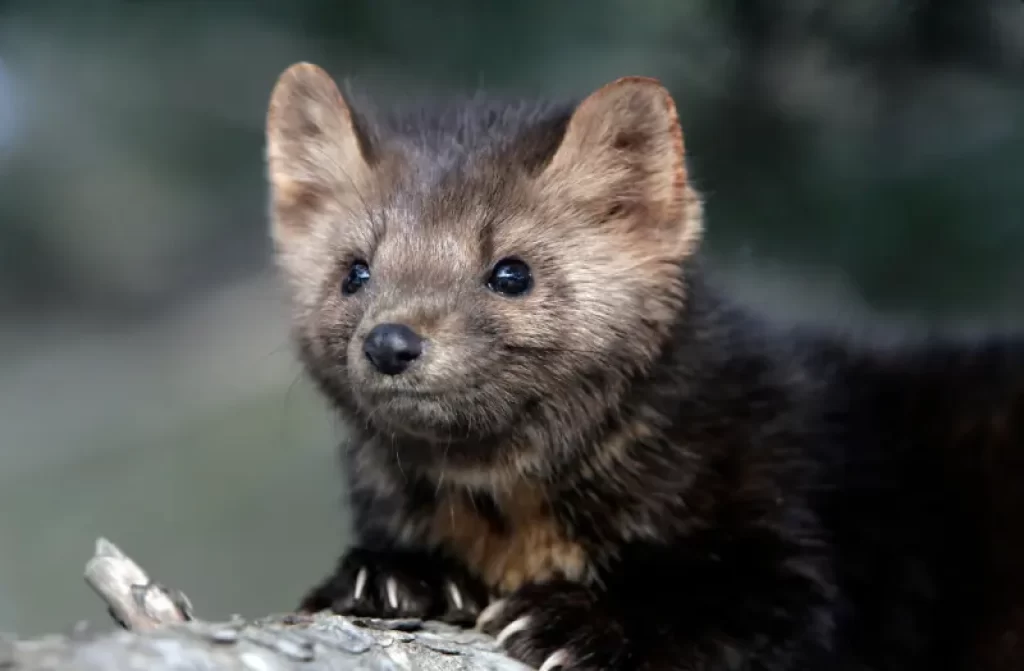
The solitary lifestyle of martens allows them to have exclusive access to resources within their territory, minimizing competition for food and potential conflicts with other individuals.
Are there any exceptions to martens’ solitary behavior?
While solitary behavior is typical for martens, there can be exceptions during the mating season when males and females come together briefly to reproduce. Additionally, encounters may occur at territorial boundaries, leading to social interactions between individuals.
Do American martens have any natural predators?
American martens have natural predators such as larger carnivores including coyotes, wolves, bobcats, and birds of prey. However, their elusive behavior and ability to climb trees help them avoid predation.
Do martens ever engage in social interactions with other martens?
While martens typically prefer a solitary lifestyle, there are instances where they may interact with other martens, particularly during mating season or encounters at territorial boundaries.
How do martens benefit from their solitary behavior?
Martens’ solitary nature allows them the freedom to roam and forage without the need for group coordination. It also reduces competition for resources within their habitat.
Are martens active during the day or night?
Martens are primarily active during the night, exhibiting nocturnal behavior. This behavior helps them avoid potential predators and take advantage of prey that are more active during nighttime.
Why do martens prefer a solitary lifestyle?
The solitary lifestyle of martens allows them to have exclusive access to resources within their territory, minimizing competition for food and potential conflicts with other individuals.
Are there any exceptions to martens’ solitary behavior?
While solitary behavior is typical for martens, there can be exceptions during the mating season when males and females come together briefly to reproduce. Additionally, encounters may occur at territorial boundaries, leading to social interactions between individuals.
How can I help conserve American martens?
Supporting conservation organizations that work towards habitat preservation, advocating for responsible forest management practices, and spreading awareness about the importance of biodiversity are some ways to contribute to the conservation of American martens.
Additionally, respecting wildlife and their habitats when visiting natural areas is crucial for their well-being.

